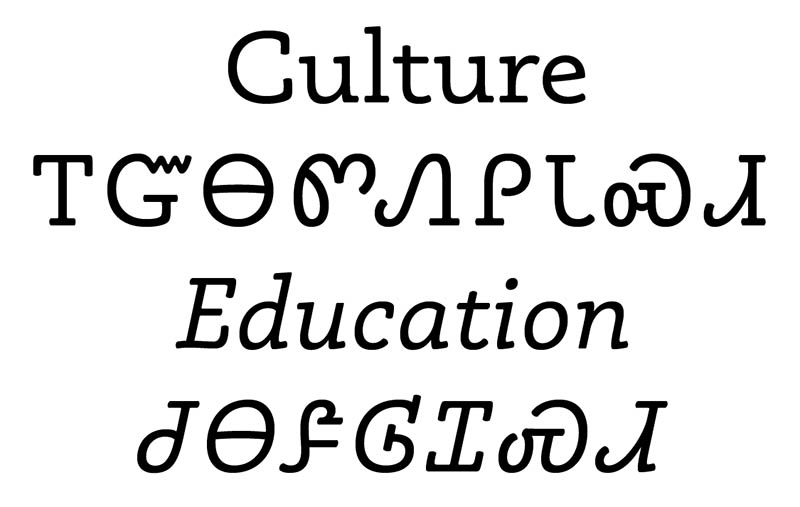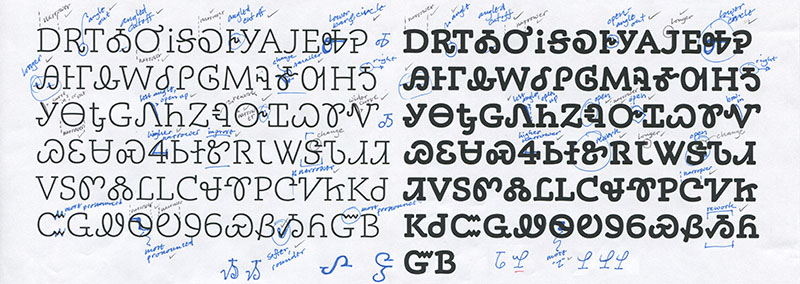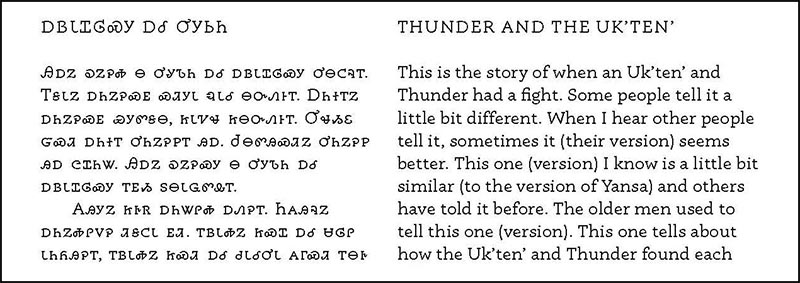Introducing Phoreus Cherokee
We’re pleased to announce the addition of Phoreus Cherokee to our library of fonts. The entire Phoreus family is available on Typekit for the web, and select styles are available for desktop sync. This is another addition to our offerings by Mark Jamra of TypeCulture; many of you may also be aware of Adobe’s popular Kinesis family, which he also designed and will be coming soon to Typekit.

Phoreus Regular and Italic examples in English and Cherokee
Phoreus Cherokee is the first font we’ve offered at Adobe which supports a Native American writing system, and one of only two multi-weight Cherokee type families in existence. It is also completely unique in containing the first true cursive italic types ever designed for the Cherokee syllabary.
The genesis of Mark’s effort was also unique. As Mark tells the story, he was at a type conference in 2011 when two representatives from the Language Technology Office of the Cherokee Nation in Tahlequah, Oklahoma, were speaking about their efforts to integrate the Cherokee language into current technologies. They finished their presentation with a request asking type designers to create Cherokee typefaces. They explained that new digital types were required to build the resources they needed to preserve their language and culture.
Mark was evidently very inspired by that talk. Shortly after the conference, he chose a Latin design he already had in progress as the proportional basis for the 85 glyphs of the Cherokee syllabary. He started reading available research, analyzed existing types, and produced form studies from manuscript images provided by the Cherokee Nation and the James Mooney manuscript collection of the Smithsonian Institution.

Hand written example using the Cherokee syllabary
“Since there were no useable multi-weight Cherokee type families at the time of their presentation, my initial strategy was to create a family of upright fonts in various weights. But when the light and bold were nearing completion, I asked what they thought of my creating an italic – not just an oblique, but a real cursive italic inspired by Cherokee handwriting. With their encouragement, I researched and culled the forms I needed from almost 180 years of manuscripts. The result – the first Cherokee cursive italic typeface design – was given a very positive evaluation by the Language Technology Office.”
– Mark Jamra

Mark Jamra of TypeCulture – Image by Dean Merrill
A key component of any language preservation effort is the degree to which one can successfully teach it to children, and influence young people to continue everyday use. Adoption by succeeding generations is critical. To help with this, Mark focused particular attention on making the glyphs distinct and uncomplicated. This resulted in type which is not only easier to read and learn, but also in a typeface with traditional Latin forms that are beautiful in their own right, and can stand on their own. We can’t stress enough that one does not need to speak or write Cherokee to get value out of these fonts.

Early proofs of Phoreus Cherokee
With the designs finished, Mark discovered that there were some unique technical challenges and some decisions to be made. Currently the Cherokee language uses only capital forms for each glyph, so Mark created small cap glyphs as well. This allows bilingual texts to be set so that the Cherokee text attains the same color as an English text set in upper and lower case. Since Unicode doesn’t yet provide for a Cherokee lowercase, the small caps are treated as alternates of the capitals. Additionally, the use of Cherokee and English glyphs together presented a need for specialized kerning.

Note the small caps which follow the first character in each sentence. Thunder and the Uk’ten’ by Willie Chopper, with translation by the Cherokee Bilingual Program, Tahlequah, OK. Cherokee Nation Newsletter, September 5, 1972.
Mark reached out to Adobe and was paired up with Miguel Sousa, one of our type designers. Working together, and using the Adobe Font Development Kit for OpenType (AFDKO), they were able to work through those issues. Ultimately they decided to place the small cap characters into typical small cap code points. Part of the full complement, they can be accessed via the Small Caps OpenType feature in products like Adobe InDesign.
Why “Phoreus”? Well, according to Mark, the name Phoreus is the ancient Greek word for bearer or carrier, and refers to type (and the Cherokee syllabary) as a vehicle of language and visual culture. We hope you will enjoy using it.
Where to find Phoreus Cherokee
Phoreus Cherokee is available for desktop and web use from Typekit. It comes in four weights, each with upright and italic styles.
Phoreus is a trademark of TypeCulture LLC.
One Response
Comments are closed.
This is a beautiful and engaging font on many levels. Mark Jamra’s sensitive research and response to the Cherokee Nation’s need is profound. The richness of the forms speak to that. Kudos to Mark Jamra!